Complete Solutions to Objective question of chapter SIMPLE HARMONIC MOTION of Class 11 book with complete answers and questions
| Class 11 | PHYSICS |
| Chapter | SIMPLE HARMONIC MOTION |
| ERRORLESS | Objective question |
| Number Of Questions | 69 |
| Academic Year | 2023-24 |
The phase of a particle executing simple harmonic motion is `pi/2` when it has
01:31View SolutionA particle starts SHM from the mean position. Its amplitude is A and time period is T. At the time when its speed is half of the maximum speed, its displacement y is
02:10View SolutionThe amplitude and the periodic time of a S.H.M. are 5 cm and 6 sec respectively. At a distance of 2.5 cm away from the mean position, the phase will be
00:53View SolutionTwo equations of two S.H.M. are `y=alpha sin (omegat-alpha) and y=b cos ( omega t -alpha)` . The phase difference between the two is
02:06View SolutionThe amplitude and the time period in a S.H.M. is 0.5 cm and 0.4 sec respectively. If the initial phase is `pi//2` radian, then the equation of S.H.M. will be
01:53View SolutionThe equation of S.H.M. is`y=a sin (2 pint + a)`, then its phase at time t is
01:05View SolutionA particle is oscillating according to the equation `X=7 cos 0.5 pit`, where t is in second. The point moves from the position of equilibrium to maximum displacement in time
02:08View SolutionA simple harmonic oscillation has an amplitude `A` and time period `T`. The time required to travel from `x = A` to ` x= (A)/(2)` is
03:05View SolutionWhich of the following expressions does not represent simple harmonic motion
01:58View SolutionA `1.00 xx 10^(-20)`kg particle is vibrating with simple harmonic motion with a period of` 1.00 xx 10^(-5)` sec and a maximum speed of `1.00xx10^(3)` m/s . The maximum displacement of the particle is
02:54View SolutionThe phase (at a time t) of a particle in simple harmonic motion tells
01:49View SolutionA particle is moving with constant angular velocity along the circumference of a circle. Which of the following statements is true
01:44View SolutionA particle is executing simple harmonic motion with a period of T seconds and amplitude a metre . The shortest time it takes to reach a point `a/sqrt2` from its mean position in seconds is
01:16View SolutionA simple harmonic motion is represented by `F(t)=10sin(20t+0.5)`. The amplitude of the S.H.M. is
01:34View SolutionWhich of the following equation does not represent a simple harmonic motion
03:10View SolutionA particle is `SHM` is discribed by the displacement function `x(t) = a cos (omegat + theta)` If the initial `(t = 0)` position of the particle `1cm` and its initial velocity is `picm//s` The angular frequency of the particle is `pi rad//s`, then its amplitude is
02:45View SolutionA particle executes a simple harmonic motion of time period T. Find the time taken by the particle to go directly from its mean position to half the amplitude.
03:54View SolutionA particle executing simple harmonic motion along y -axis has its motion described by the equation `y = A sin (omega t )+ B`. The amplitude of the simple harmonic motion is
01:47View SolutionA particle excuting `S.H.M.` of amplitude `4 cm `and `T = 4` sec .The time take by it to move position extreme position to half the amplitude is
02:30View SolutionWhich one of the following is an oscillatory motion.
02:19View SolutionA particle is moving in a circle with uniform speed its motion is
03:23View SolutionTwo simple harmonic are represented by the equation `y_(1)=0.1 sin (100pi+(pi)/3) and y_(2)=0.1 cos pit`.
The phase difference of the velocity of particle 1 with respect to the velocity of particle 2 is.03:04View SolutionTwo particles are executing S.H.M. The equation of their motion are `y_(1) = 10 sin (omega t + (piT)/4),y_(2)=25 sin (omegat+(sqrt3piT/4))` . What is the ratio of their amplitude
01:16View SolutionThe periodic time of a body executing simple harmonic motion is 3 sec. After how much time from time `t=0` , its displacement will be half of its amplitude
01:46View SolutionA system exhibiting S.H.M. must possess
01:39View SolutionIf `x=a sin(omegat+(pi)/6)` and `x= a cos omegat`, then what is the phase difference between the two waves?
02:48View SolutionTwo particles execute SHM of same amplitude and frequency on parallel lines. They pass one another when moving in opposite directions each time their displacement is one third their amplitude. What is the phase difference between them?
09:00View SolutionThe displacement of a particle varies with time as `x = 12 sin omega t - 16 sin^(2) omega t` (in cm) it is motion is `S.H.M.` then its maximum acceleration is
01:42View SolutionA linear harmonic oscillator of force constant `2 xx 10^6 N//m` and amplitude (0.01 m) has a total mechanical energy of (160 J). Its.
03:45View SolutionA particle of mass (m) is executing oscillations about the origin on the (x) axis. Its potential energy is `V(x) = k|x|^3` where (k) is a positive constant. If the amplitude of oscillation is a, then its time period (T) is.
02:47View SolutionTwo blocks `A` and `H`. each of mass `m`, are connected by a massless spring of natural length `I`. and spring constant `K`. The blocks are initially resting in a smooth horizontal floor with the spring at its natural length, as shown in Fig. A third identical block `C`, also of mass `m`, moves on the floor with a speed `v` along the line joining `A` and `B`. and collides elastically with `A`. Then
 02:22View Solution
02:22View SolutionA cylinder piston of mass `M` sides smoothlly inside a long cylinder closed at and enclesing a cartin mass of gas The cylinder is kept with its axis horizantal if the pistan is distanced from its equations positions it oscillation simple harmoniically .THe period of oscillation will be
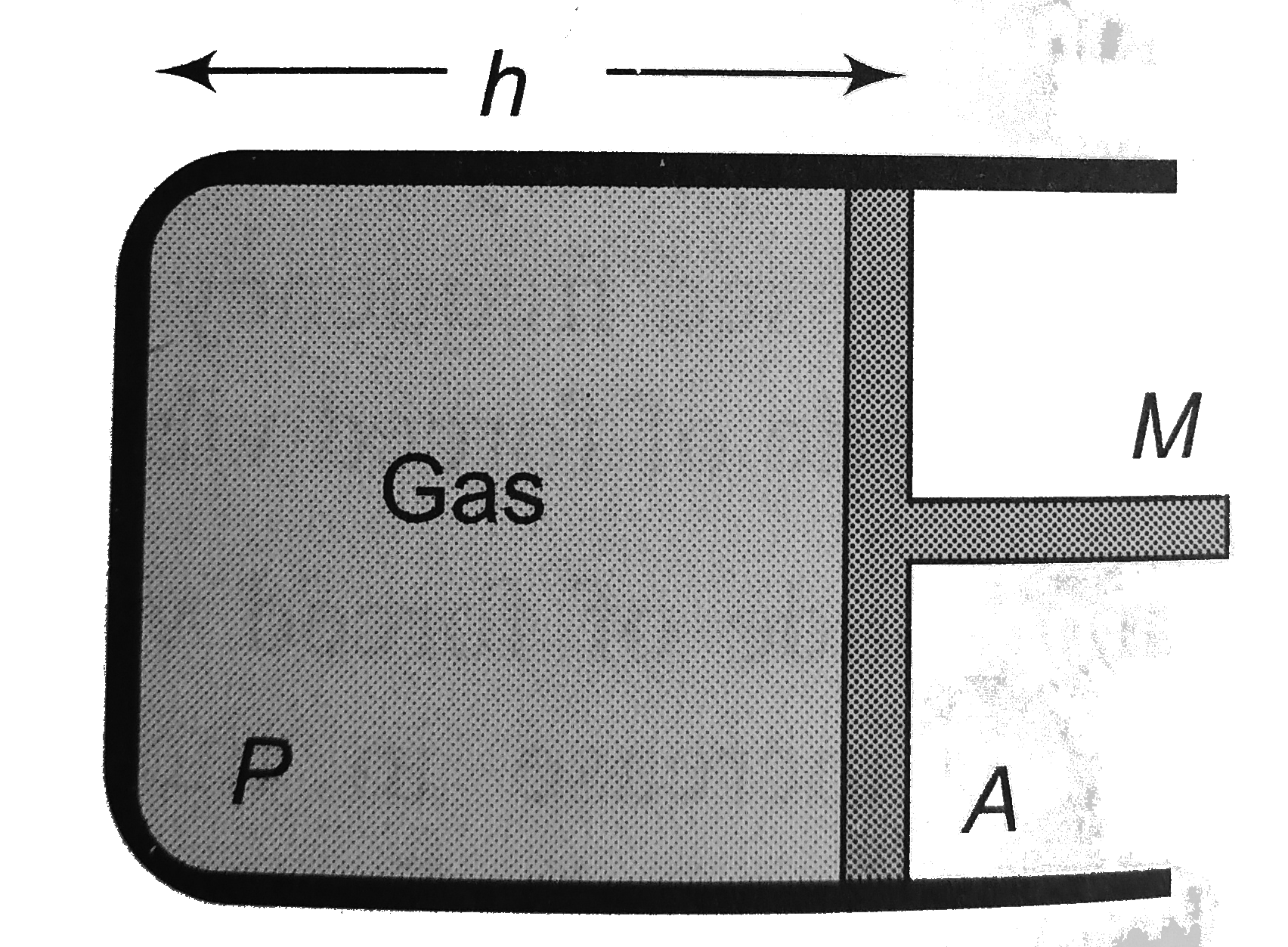 07:40View Solution
07:40View SolutionA sphere of radius r is kept on a concave mirror of radius of curation `R`. The arrangement is kept on a horizontal surface (the surface of concave mirror is friction less and sliding not rolling). If the sphere is displaced from its equilibrium position and left, then it executes `S.h.M.` The period of oscillation will be
03:41View SolutionThe amplitude of vibration of a particle is given by `a_m=(a_0)//(aomega^2-bomega+c)`, where `a_0`, a, b and c are positive. The condition for a single resonant frequency is
02:54View SolutionA `U` tube pf uniform born of cross sectional area `A` has been set up vertically with open ends facing up Now `m gm` of a liquid of density `d` is poured into it. The column of liquid in this tube will oscillation with a period `T` such that
04:34View SolutionA particle is performing simple harmonic motion along `x-`axis with amplitude `4 cm` and time period `1.2 sec` .The minimum time taken by the particle to move from `x = 2 cm to x = +4 cm` and back again is given by
03:32View SolutionA large horizontal surface moves up and down in SHM with an amplitude of 1 cm . If a mass of 10 kg (which is placed on the surface) is to remain continually in contact with it, the maximum frequency of S.H.M. will be
03:11View SolutionDue to some force `F_(1)` a body oscillates with period `4//5s` and due to other force `F_(2)` it oscillates with period `3//5s`. If both the forces acts simultaneously in same direction then new period is
03:38View SolutionA horizontal platform with an object placed on it is executing S.H.M. in the vertical direction. The amplitude of oscillation is ` 3. 92 xx 10 ^(-3)` m. what must ve the least period of these oscillations. So that the object is not detached from the platform
02:37View SolutionA particle executes simple harmonic motion between `x = -A and x = + A`. The time taken for it to go from `0 to A//2 is T_1 and to go from A//2 to (A) is (T_2)`. Then.
02:52View SolutionA simple pendulum of length L and mass (bob) M is oscillating in a plane about a vertical line between angular limits `-phi` and `+phi` For an angular displacement `theta(|theta|ltphi).`the tension in the string and the velocity of the bob are T and v respectively. The following relations hold good under the above conditions
`T-Mgcostheta=(Mv^(2))/(L)`
`T costheta=Mg`
The magnitude of the tangential acceleration of the bob `|a_(T)|=gsintheta`
`T=Mgcostheta`04:45View SolutionTwo simple pendulums of length `0.5 m` and `0.2 m` respectively are given small linear displacement in one direction at the same time. They will again be in the same phase when the pendulum of shorter length has completed oscillations
01:22View SolutionThe bob of a simple pendulum it displaced position `O` to a equilibrium position `Q` which is at height h above `O` and the bob to then mass released Assuming the mass of the bob is m and time period `2.0` sec of oscillation to be string when the bob passes through `O` is
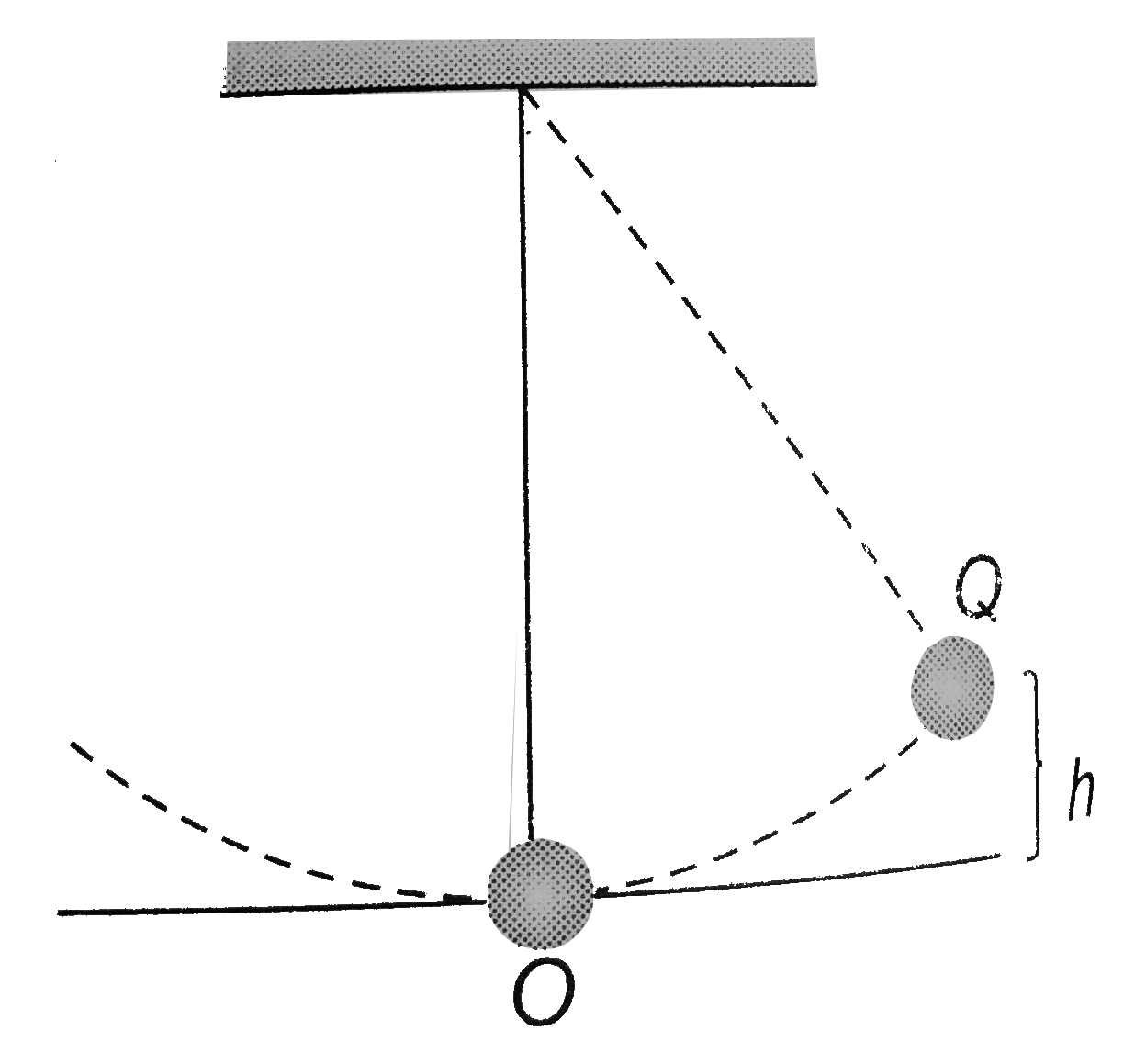 02:52View Solution
02:52View SolutionThe matallic bob of a simple pendulum has the relative density `rho`. The time period of this pendulum is `T` it the metallic bob is immersed in water the new time period is given by
02:28View SolutionA clock with an iron pendulum keeps correct time at `20^(@)C`. How much time will it lose or gain in a day if the temperature changes to `40^(@)C`. Thermal coefficient of liner expansion `alpha = 0.000012 per^(@)C`.
03:29View SolutionThe period of oscillation of a simple pendulum of length (L) suspended from the roof of a vehicle which moves without friction down an inclined plane of inclination (prop), is given by.
04:33View SolutionThe bob of a simple pendulum executm simple harmonic motion in water with a period t, while the period of oscillation of the bob is `t_(0)` in air. Negleting frictional force of water and given that the density of the bob is (4//3)xx1000 kg//m^(3).
What relationship between t and `t_(0)` is true.02:55View SolutionA spring of force constant k is cut into two pieces such that one piece is double the length of the other. Then the long piece will have a force constant of
05:45View SolutionOne end of a long metallic wire of length (L) is tied to the ceiling. The other end is tied to a massless spring of spring constant . (K.A) mass (m) hangs freely from the free end of the spring. The area of cross- section and the Young's modulus of the wire are (A) and (Y) respectively. If the mass is slightly pulled down and released, it will oscillate with a time period (T) equal to :
05:36View SolutionOn a smooth inclined plane, a body of mass M is attached between two springs. The other ends of the springs are fixed to firm supports. If each spring has force constant K , the period of oscillation of the body (assuming the springs as massless) is
 02:09View Solution
02:09View SolutionA particle of mass (m) is attached to a spring (of spring constant k) and has a narural angular frequency omega_(0). An external force `R(t)` proportional to cos omegat(omega!=omega)(0) is applied to the oscillator. The time displacement of the oscillator will be proprtional to.
02:53View SolutionA `15 gm` ball is shot from a spring whose spring has a force constant of `600 N//m`. The spring is compressed by `5 cm`. The greater possible horizontal range of the ball for this compression is
02:28View SolutionAn ideal spring with spring constant k is hung from the ceiling and a block of mass M is attached to its lower end. The mass is released with the spring initially unstretched. Then the maximum extension in the spring is
01:25View SolutionThe displacement `y` of a particle executing periodic motion is given by `y = 4 cos^(2) ((1)/(2)t) sin(1000t)`
This expression may be considereed to be a result of the superposition of02:36View SolutionThree simle harmionic motions in the same direction having the same amplitude (a) and same period are superposed. If each differs in phase from the next by `45^@`, then.
05:33View Solutionthe funcation ` sin^(2)(omegat)` repesents
03:30View SolutionA simple pendulum has time period `T_(1)`. When the point of suspension moves vertically up according to the equation `y=kt^(2)` where `k=1m//s^(2)` and `'t'` is time then the time period of the pendulum is `T_(2)` then `(T_(1)//T_(2))^(2)` is
02:26View SolutionA simple pendulum is hanging from a peg inserted in a vertical wall. Its bob is stretched in horizontal position from the wall and is left free to move. The bob hits on the wall the coefficient of restitution After how many collsions the amplitude of vibration will become less than ` 60 ^(@)`
04:01View SolutionA brass cube of side a and density `sigma`is floating in mercury of density `rho`. If the cube is displaced a bit vertically, it executes S.H.M. Its time period will be
03:14View SolutionTwo identical balls (A) and (B) each of mass (0.1 kg), are attached to two identical massless springs. The spring - mass system is constrained to move inside a riged smooth pipe bant in the form of a circle as shown in Fig. The pipe is fixed in a horizontal plane.
The centres of the balls can move in a circle of radius (0.06 pi) meter. Each spring has a natural length `zof0.06 pi` meter and spring spring constant5 `0.1 N//m`. Initially, both the balls are displaced by an angle `theta = pi// 6` radian with respect to the diameter (pQ) of the circle (as shown in Fig.) and released from, rest.
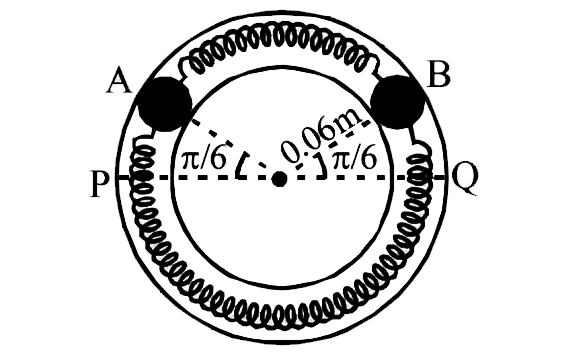 .
.
(i) Calculate the frequency of oscillation of ball (B).
(ii) Find the speed of ball (A) when (A) and (B) are at the two ends of the diameter (PQ).
(iii) What is the total energy of the system.08:16View SolutionA disc of radius `R` and mass `M` is pivoted at the rim and it set for small oscillations. If simple pendulum has to have the same period as that of the disc, the length of the simple pendulum should be
03:11View SolutionOne end of a spring of force constant `k` is fixed to a vertical wall and the other to a block of mass `m` resting on a smooth horizontal surface There is another and wall at a distance `x_(0)` from the block The spring is then compressed by `2x_(0)` and released The time taken to strike the wall is
 03:18View Solution
03:18View SolutionThree masses 700 g , 500 g , and 400 g are suspended at the end of a spring a shown and are in equilibrium. When the 700 g mass is removed, the system oscillates with a period of 3 seconds, when the 500 gm mass also removed. It will oscillate with a period of
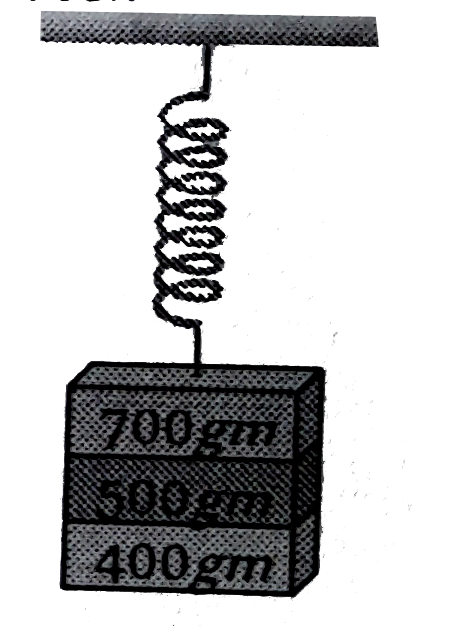 02:14View Solution
02:14View SolutionA particle of mass 'm' is attached to three identical springs `A,B` and `C` each of force constant 'K' as shown in figure. If the particle of mass 'm' is pushed slightly against the spring 'A' and released the period of oscillations is
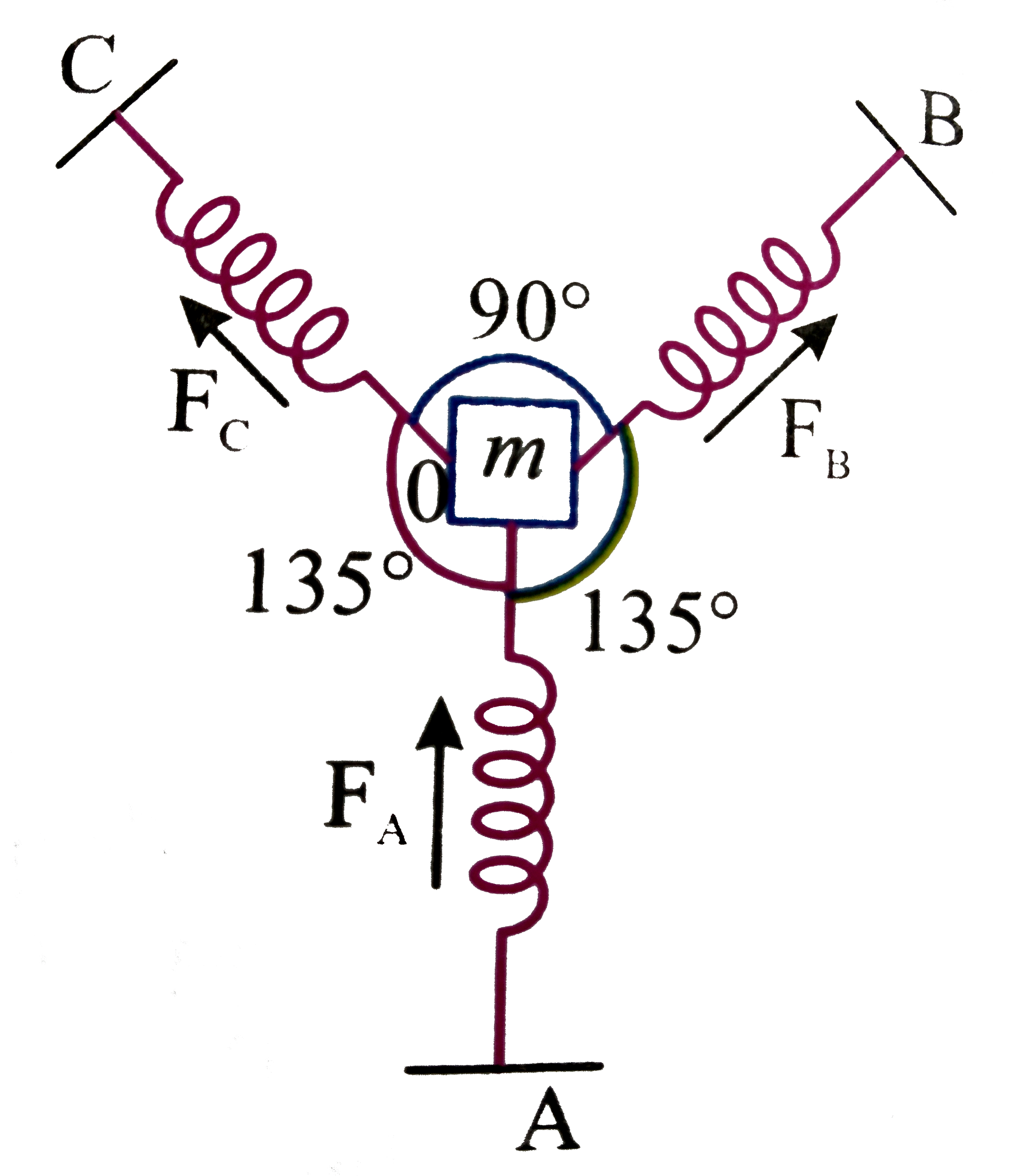 06:29View Solution
06:29View SolutionA metallic sphere is filled with water and hung by a long thread. It is made to oscillate. If there is a small hole in the bottom through which water slowly flows out, the time period will
04:19View SolutionTwo simple pandulum whose lengths are `100cm` and `121cm` are suspended side by side. Then bobs are pulled together and then released. After how many minimum oscillations of the longer pendulum will two be in phase again. ?
04:03View SolutionThe amplitude of damped oscillator becomes half in one minute. The amplitude after 3 minutes will be `1//x` times the original, where x is
02:25View SolutionWhich of the following functionss represents a simple harmonic oscillation ?
03:19View SolutionA uniform rod of length 2.0 m is suspended through an end and is set into oscillation with small amplitude under gravity. The time period of oscillation is approximately
01:27View Solution
Objective question questions and complete solutions for chapter SIMPLE HARMONIC MOTION of UNIVERSAL BOOK DEPOT 1960 PHYSICS (HINGLISH) of Class 11
